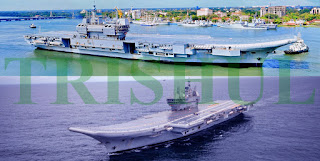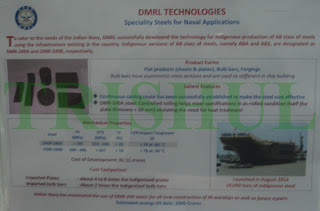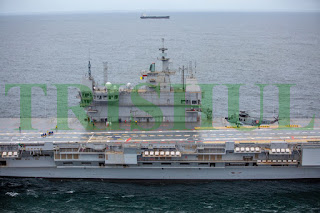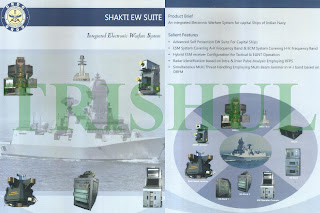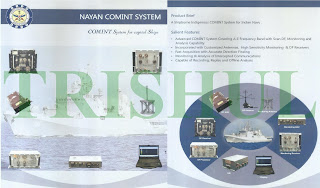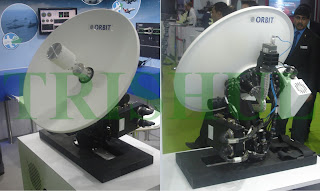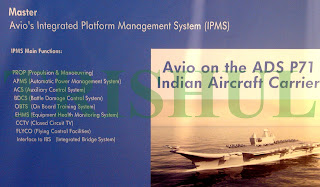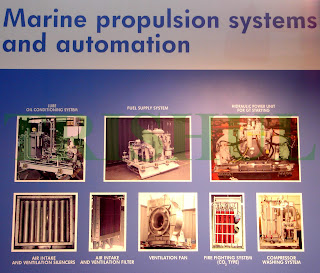Designed by the Directorate of Naval Design of the Indian Navy (IN) under Project 71, the 37,500-tonne Project 71 Indigenous Aircraft Carrier’s (IAC-1) construction at a cost of Rs.3,261 crore was sanctioned by India’s Cabinet Committee on National Security (CCNS) in January 2003. However, metal-cutting commenced only in November 2006, while the keel-laying was done on February 28, 2009 at the MoD-owned Cochin Shipyard Ltd (CSL). The 260-metre-long and 14-storey high vessel was launched on August 12, 2013 in a pontoon-assisted technique, in a first in India, when limited dock space prevented further construction. CSL made a special jig to move the 104-tonne ‘A bracket’ that buttresses the propeller shafts—as long as 99 metres and 69 metres—on the aircraft carrier’s hull. It was then envisaged that the IAC-1 would be delivered to the IN by December 2018, followed by service-induction in October 2020. The three-year delay happened due to non-availability of 18 types of major equipment related to the IAC-1’s on-board Nevskoye Design Bureau-designedaviation hanger from Russia. This in turn led to a 600% project cost overrun, or Rs.19,341 crore. The IAC-1 successfully completed the contractor’s dry-dock work package (fast-cruise workup trials) in December 2019, while the wet-basin trials, conducted for proving of the propulsion, transmission and shafting systems, were held between September and November 2020. The Builder’s Sea-Trials commenced on August 4, 2021.
The IAC-1 has a beamwidth of 62 metres at the widest part and has a draught of 30 metres minus the superstructure. Up to 90% of the body of the IAC-1 was designed and made in India and involved about 200 big and small companies from the public-sector DPSUs and the private-sector. The vessel has 2,300 compartments designed to user specifications for crew, systems, piping, fluids, ventilations and cabling. The sailor living spaces (with provision to accommodate eight women officers) on the sixth deck from the top, also houses 92 impressive state-of-the-art sanitation spaces, with modern showers and vacuum toilets.The DRDO’s Naval Materials Research Laboratory along with CSL trained about 500 new welders for fabricating the vessel’s superstructure. The Defence Metallurgical Research Laboratory- (DMRL) developed DMR-249A steel came from SAIL’s plants in Raurkela in Orissa, Bokaro in Jharkhand and Bhilai in Chattisgarh; the Main Switch Board, steering gear and watertight hatches were manufactured by Larsen & Toubro in its plants in Mumbai and Talegaon; the high-capacity air conditioning and refrigeration systems were manufactured in Kirloskar’s plants in Pune; most of the pumps were supplied by Best & Crompton, Chennai; Bharat Heavy Engineering Ltd (BHEL) supplied the eight diesel alternators, each generating 3mWe power; the massive gearbox was supplied by Gujarat-based Elecon Engineering; the tens of thousands of electrical cabling (running into 1,500km length) was supplied by Kolkata-based Nicco industries; Kolkata is also where the ship’s anchor chain cable is manufactured.
The CMS-71 combat management system (CMS) was developed by Tata Power Strategic Engineering Division (TO-SED) in collaboration with the IN’s in-house Weapon and Electronics System Engineering Establishment (WESEE) and Russia-based FRPC MARS JSC (which supplied the Integrated Bridge Control System). Its installation work began on March 29, 2019 and was completed by July that same year. The CMS-71 is the second CMS to be developed by a private-sector entity for the IN, the first being the SARAANSH CMS for the INS Arihant S-73 nuclear-powered SSGN.
The IAC-1 will be able to accommodate 20 MiG-29K MRCAs, five Ka-28PL ASW helicopters and five Ka-31 AEW helicopters. Its crew complement will comprise 160 officers and 1,400 sailors. Powered by four HAL-assembled and GE-developed LM-2500 marine industrial gas-turbines, the IAC-1 will have an endurance of around 7,500 nautical miles while cruising at a speed of 18 Knots. For the IAC-1/INS Vikrant, the IN selected the Mk.7 hydraulic damping arresting system from the US Navy, while US-based Wire Rope Industries Inc has supplied the arrester cables. Another US-based company, Engineered Arresting Systems Corp, has supplied the arrester barriers. Italy-based AVIO supplied the Integrated Platform Management System (IPMS). Other hardware to go on board IAC-1 include twin side-mounted aircraft elevators and their chain-drives from UK-based MacTaggart Scott, while Wire Rope Industries has supplied the ammunition hoisting elevators. The CBRN detection sensors were supplied by US-based Bruker Daltonics, which has for the past decade supplied almost all the CBRN detection sensors for all three of India’s armed services (while the remaining have come from French OEMs). The IAC-1’s ring-laser gyro-based inertial navigation system (RLG-INS) uses SAFRAN/SAGEM-built SIGMA-40 ring laser-gyros. UK-based TEX Special Projects and its Indian industrial partner PRATEX Power Vision Pvt Ltd–India’s leading supplier of marine glazing solutions designed, manufactured and project managed the installation of the ultra-high specification glazing, frames and ancillaries. Russia-based Concern CSRI Elektropribor JSC has supplied the LUNA-3E optical landing system and its Ladoga and Saturn deck-lighting systems, plus the Rezistor K4 aircraft homing system.
The IN’s Warship Overseeing Team (WOT) along with CSL is responsible for the conduct of the three-stage trails process of the IAC-1 prior to the warship’s delivery to the IN. All three stages are detailed below.
Fast-Cruise Work-up Trails
The fast-cruise work-up trails comprised of the following activities:
1. Make all preparations for getting underway.
2. Station the manoeuvring watch/sea and anchor detail.
3. Simulate getting underway and return to port. (Day and Night)
4. Walk through all major sea-trial evolutions.
5. Walk through the cycling of hull and back-up valves to be tested.
6. Exercise the reduced visibility detail.
7. Spot-check storage and availability of spare parts and tools. Verify adequacy of stores and provisions.
8. Conduct the following emergency drills: a. Fire b. Collision c. Flooding d. Toxic gas emission e. Abandon Ship f. Man Overboard h. Loss of AC Power i. Emergency Ventilation j. Loss of Air Conditioning/ACW k. Loss of Lighting l. Loss of Interior Communications m. Loss of Steering n. Engine Casualty Control o. Flight deck and hangar deck crash/fire drills, barricade drills, and MOVLAS drills.
9. Set General Quarters and exercise the crew at battle stations.
10. Conduct communications and ECM drills.
11. Anchor (walk-through).
12. Exercise damage-control party with emergency and damage control equipment.
13. Operate atmosphere control equipment and take air samples.
14. Operate air conditioning plants to demonstrate ability to carry the maximum existing ship's air conditioning load or 100% capacity.
15. Operate fresh water/seawater heat exchangers at sufficient load to demonstrate proper operation.
16. Simulate underway conditions, performing all evolutions and operating all equipment.
17. Conduct exercises in casualties to LR-SAM tube-breather valves to include flooding and introducing toxic gases in the LR-SAM VLS cells from gas generator.
18. Simulate crew transfer at sea.
19. Conduct competitive and non-competitive drills and exercises such as aircraft tracking and aircraft control.
20. Light-off main propulsion plant, shift to ship's power and run all engines with steam for a short period of time.
21. Man Towing/Salvage/Fueling Stations.
22. Set Flight Quarters as applicable.
23. Operate the 40-tonne aircraft salvage crane.
Wet-Basin Trials
These comprised of the following activities:
1) Check all sound powered/interior communications circuits between all stations.
2. Test all alarms, i.e., General Quarters, Collision, etc.
3. Test each indication on Ballast Control Panel.
4. Test whistle.
5. Check emergency lights.
6. Operate all hydraulic plants using each installed pump.
7. Conduct a complete air charge using only the vessel’s compressors.
8. Flood sanitary tanks and then blow/pump them.
9. Operate each main vent valve in hand and power. Following operation, with vent valves shut.
10. Operate the outboard induction valve in hand and power.
11. Operate the diesel engine exhaust valve in hand and power.
12. Operate on-board induction valves.
13. Test operation of all radio transmitters and receivers using all antennas.
14. Operate all radar equipment at rated conditions.
15. Operate all sonar equipment at rated conditions.
16. Take and plot fixes using all navigation equipment and each antenna.
17. Test operation of drain pump(s) from all operating locations using each bilge suction.
18. Test operation of portable submersible pump from each installed outlet.
19. Operate each lube oil system, including pumps, controllers, purifiers and indicators.
20. Start RLG-INS/ESGN and gyrocompass; determine that they settle out; take azimuth; check all repeaters.
21. Check fresh water system, have water samples analysed.
22. Test capstans.
23. Test stabilisers and rudders as applicable and tilting in hand, normal power and emergency. Test normal and emergency plane angle indicators.
24. Operate steering system. Test normal and emergency rudder angle indicators.
25. Operate each watertight door and hatch.
26. Check operation of compartment hatches/scuttle fittings.
27. Operate each bulkhead flapper and each inter-compartment air-salvage valve.
28. Turn on and check navigation/running lights for brightness and proper lenses (to be done at night). Includes Flight Deck lighting.
29. Check air conditioning, chill water, ventilation, and heating systems.
30. Check out all galley, messing, and service equipment.
31. Check bilge flooding alarms.
32. Check dummy log.
33. Check all high-pressure (HP) and low-pressure (LP) air system.
34. Operate distilling units.
35. Check out anchor windlass and brake operation.
36. Check battery water system.
37. Check out atmosphere monitoring equipment, both installed and portable.
38. Operate oxygen generator, CO2 scrubbers, CO burners, and emergency air breathing system.
39. Engage and disengage the clutch.
40. Test Main Engines.
41. Check out all TV monitoring systems.
42. Check out small arms lockers and security devices.
43. Check out all IFF equipment.
44. Check out degaussing equipment (where applicable).
45. Check out Hangar-Bay doors.
46. Check out damage-control equipment.
47. Inspect and operate oxygen and nitrogen systems.
48. Check out all tank-level indicating systems.
49. Check out Flight Deck communications.
50. Check out meteorological equipment.
51. Check out graphics preparation/display equipment.
52. Check out Weapon Systems. Check to include loading of dummy LR-SAM at each launch station, transmission of fire-control signals and operation of launchers in all modes.
53. Operate all electrical/mechanical medical equipment.
54. Inspect all compartments for proper stowage and cleanliness.
55. Inspect diesel fuel-oil systems.
56. Test and inspect jet blast deflectors.
57. Test and inspect JP-5 fuel systems.
58. Test and inspect all aircraft starting and handling equipment.
59. Test and inspect aircraft landing equipment including landing signals officer equipment, arresting gear, aircraft crash-barriers, as applicable.
60. Operate all RAS equipment.
61. Inspect paint lockers and sprinkling systems.
62. Operate all accommodation ladders.
63. Operate all conveyors.
64. Launch and raise motor whaleboat.
65. Operate all RHIBs.
66. Test and inspect lifeboat/life-raft stowage and launch equipment.
67. Test and inspect all elevators in all modes of operation.
68. Test and inspect all fire-fighting systems.
69. Test and inspect refrigeration systems.
70. Test and inspect all seawater cooling systems.
71. Operate stern gate doors.
72. Operate boat-handling cranes.
73. Test and inspect aircraft elevators.
74. Test and inspect aircraft launch/recovery equipment.
Builder’s Sea-Trials
Warship construction is a meticulous process and still for all practical reasons, many shortcomings of a vessel emerge out during sea-trials. The ‘Builder’s Sea-Trials’ are what actually put a vessel to test and must be carried out diligently in a punctilious manner, with every concerned person present on board to assess and record the measurements and at the same time try to identify the cause of any malfunctioning. It wouldn’t be an exaggeration to say that these tests, once conducted and analysed, help make a warship safer as well as allowing it to sail smoothly by conforming to all rules and regulations of the classification societies. Every shipyard after constructing and launching a vessel performs a set of tests to ensure that all systems of the vessel meet the corresponding requirements assigned by the owner under the contract and at the same time conform to the rules and regulations of the approving classification society. Typically, 10% of the total contract amount is yet to be paid to the shipyard after successful delivery of the warship to the customer/end-user and in case of any faults, the penalties will take the form of a deduction from the same. Broadly, there are 11 parameters that are validated during the sea-trials.
Draught Measurement.Draught is an important matter of concern for any warship as it shapes and regulates a number of hydrostatic and hydrodynamic parameters. Before measuring the draught, it is imperative to measure the density of water in which the warship ought to be floating and hence the specific gravity of seawater is measured. Accordingly, the draught is measured in that fluid (same water) and in case the warship is not floating at the required draught it is corrected since the very purpose of the sea-trials is to prove guaranteed speed at a particular draught.
Anchor Test.A warship’s Anchor plays an important part in keeping a vessel stationary as per the requirement such as in ports and harbours. It is imperative for a vessel’s position to become dynamically stable to prevent any mishap such as collision with other nearby vessels in port. Hence, the Anchor Test is performed to check the functioning of the entire anchoring mechanism. The following are the points outlining the test procedure and requirements during sea-trials: A) The anchor test is conducted up to a depth of sea of 80 metres. B) The anchor chain is dropped freely (both from Port and Starboard one after the other). During this the dropping brake is applied up to three times to test its capacity. C) Finally, the Anchor is heaved and the heaving speed is measured by noting the downtime on the stopwatch for heaving each chain length. As per rule, the hoisting speed should not be less than 9 metres/minute.
Steering Gear Test.Imagine a situation where a warship’s manoeuvrability has been compromised due to malfunctioning of the steering gear. The following points shed light on the test procedure and the necessary requirements for the same. A)First of all, the vessel should be moving at full ahead speed. B) Now the rudder is moved from 35-degree Port to 35-degree Starboard (called hard to port and hard to starboard in nautical verbiage) by using pressure from one hydraulic pump and then subsequently using two pumps. C) As per class requirement, the time taken by the rudder in going from hard port to hard starboard or vice versa should be less than 28 seconds.
Main Engine Endurance Test. The driving and prime component of a warship on failure can make even the most experienced sailors and engineers worried and hence almost nine (09) measurements are taken while testing the propulsion system during sea-trials. The marine gas-turbines should be run for six (06) straight hours at full rated r.p.m in order to test their performance at full load. For the initial two (02) hours, the marine gas-turbines are run on Light Diesel Oil (LDO) and for four (04) hours on Heavy Fuel Oil (HFO) and lastly again for two hours on LDO. This is done in order to check the change-over process from HFO to LDO. The following are the measurements recorded during this test: Noise levels are recorded at various places on the warship; Similarly, vibration levels are recorded at different places; The capacity of Fresh Water Generator is recorded; The performance of Exhaust Gas Boiler is assessed; Fuel Oil Consumption in litres/hour is recorded and Specific Fuel Oil Consumption (SFOC) in gm/kW/hr is calculated; Power is recorded from Shaft Horsepower Meter; Load on Diesel Generator Sets is recorded; All systems are checked for any leakages; and the temperatures and pressures of all systems (Fresh Water (FW)/ Lube Oil (LO)/ Fuel Oil (FO)/ Sea Water (SW) / Exhaust Gas) are measured and recorded.
Speed Trials.Suppose the warship’s end-user cited a speed requirement of 15 Knots, but the vessel is operating at a speed of 14 knots at the required draught. What happens next is a penalty imposed on the shipyard. However, there is a grace margin of 0.3 Knots above which for every 0.1 Knots the penalty increases. Speed Trials are carried out to check the speed of the vessel at the required draught as per the contract. The test is carried out at a minimum of three (03) powers—75%, 85%, 100%, Maximum Continuous Rating (MCR), or any other power-rating as per the contract. The speed at each power is measured using the Global Positioning System (GPS) by running the warship in two opposite directions (called double-run). Now the speed measured as per the supposed three powers are plotted to give a speed-power curve. Finally, from the curve, the speed corresponding to the required power as outlined in the contract is noted.
Crash-Stop Tests.In this, the stopping ability of a warship is assessed. When the vessel is moving at full ahead speed, the engine is reversed to full astern to commence stopping of the vessel. The time taken by the vessel to come to a complete halt is recorded. The distance travelled by the warship starting from the moment the lever was put to full astern until the warship stopped is noted. This test is also carried out from full astern to full ahead condition.
Astern Running Test. All vessels should have the manoeuvring capability to run in the astern direction as per rules. Hence during the sea-trials, the vessel is run in the astern direction at about 70% ahead MCR by running the engine in reverse direction.
Turning Circle Test. This test is carried out to measure the diameter of the circular path which the warship starts to traverse as soon as the rudder is put hard to port or hard to starboard. The vessel is run to complete one circle. The diameter of the completed circle is measured using GPS. In addition, the tilt of the vessel when making such turns is also measured.
Black-Out Test.This is aptly called ‘black-out test’ as there is a complete blackout on board a warship. This happens as during this test all the main generators (typically three in number) are shut down and the automatic starting of Emergency Diesel Alternator (DA) set is observed. As per rule, the emergency DA set should come online within a time span of 45 seconds.
Mission Electronics Equipment Tests. Operation of equipment such as radars, fire-control systems, optronic sensors, communications systems, EW suites etc. are also checked out for seaworthiness in various sea-states during sea-trials.
Aviation Operations.These, involving both fixed-wing and rotary-winged platforms, include both staggered and surge launch and recovery of such platforms in fully weaponised modes while out at sea in various sea-states by both day and night, validation of arming and de-arming such platforms, and validation of aircraft stowage/dispatch-to-the top-deck protocols.

